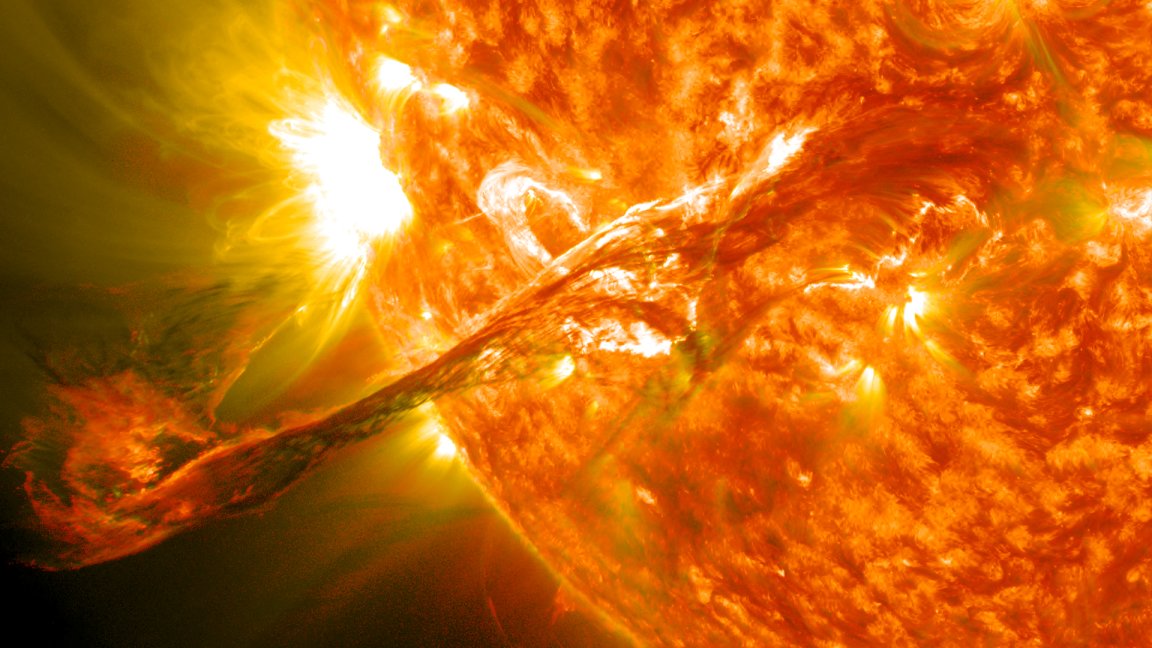
Solar Shutdown
In 1859, a coronal mass ejection (CME) — a release of charged particles from the Sun — threw Earth’s young communication network into disarray. Telegraph systems in Europe and North America failed, their pylons throwing sparks, starting fires, and, in some cases, shocking operators. Meanwhile, auroras rippled across the sky from the poles to the Caribbean, Hawaii, Colombia, and Sub-Saharan Africa.
Fortunately, in 1859, the world order didn’t completely rely on electricity or these communication systems. But what would happen if a storm like this hit Earth today?

Coronal mass ejections are made up of slow-moving magnetized plasma that creates powerful electrical currents in Earth’s atmosphere. According to experts interviewed by Gizmodo, the electrical ground currents picked up from the atmosphere during a large CME would melt the copper inside electrical transformers, causing massive power outages. That means no internet, refrigeration, heating, air conditioning, or gas pumps, and in many cities, no toilets or sewage systems.
Hospitals would be left to rely on backup generators, which, as we have seen, don’t last long in times of crisis. GPS systems would be knocked out, meaning many airplanes that run on GPS would have to rapidly swap to navigating and landing manually. Astronauts aboard the International Space Station (ISS) would lose communication with Earth as they were bathed in dangerous radiation.
The potential economic and social impact of such a storm could be catastrophic. According to a 2009 National Academies of Sciences report, if we were hit by one today, the cost would be more than $2 trillion, and other reports have estimated figures as high as $10 trillion.
Manasvi Lingam and Avi Loeb of the Harvard-Smithsonian Center for Astrophysics believe future losses could total $20 trillion as we become more dependent on technology. However, they have an idea for how we could prepare for this catastrophe before it happens, ultimately saving trillions of dollars.
Building Our Defenses
Research has suggested that such an event has roughly a 12 percent chance of happening in the next 10 years — in fact, in July 2012, a flare approximately the size of the 1859 storm very narrowly missed us. To protect Earth in the event of another large flare, Lingam and Loeb propose that we construct a massive space-borne shield.
While a physical shield would block sunlight (a bad thing for, well, all life on Earth) and an electric shield would mess with the balance of positive and negative particles reaching Earth, the authors believe a magnetic field is a viable option.
“The related engineering project could take a few decades to construct in space,” Loeb told Gizmodo. “The cost for lifting the needed infrastructure to space (weighing 100,000 tons) will likely [cost around] hundreds of billions of dollars, much less than the expected [solar storm] damage over a century.”

Anders Sandberg, a research fellow at Oxford University’s Future of Humanity Institute, told Gizmodo that he thought Lingam and Loeb’s shield would likely cost much more than estimated and that their model makes too many assumptions about the planet’s changing economies. However, he did think it was feasible on the engineering side — a one-centimeter wide, Earth-sized loop of copper wire powered by a solar farm would be enough to accomplish the task.
For a civilization that relies on technology to function, the benefit of such a shield could very well outweigh the costs. As Daniel Baker, Professor of Astrophysical and Planetary Science at the University of Colorado, told NASA, if the 2012 storm that narrowly missed Earth had hit us, we’d still be trying to recover years later.